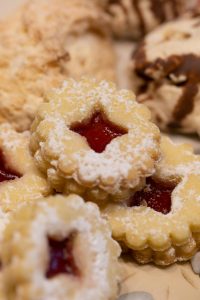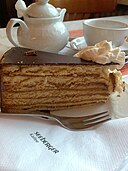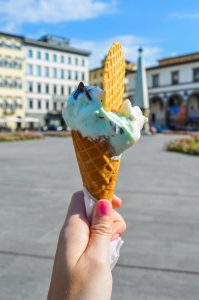6.9 Um den Pudding gehen

Guten Appetit!
Zum Aufwärmen machen wir unseren Tagesminiplausch und eine Wiederholung.
Wiederholung
In the previous lesson, you learned about die warme Mahlzeit. Let’s review what you have learned.
Was isst du gern zur warmen Mahlzeit? What foods might you enjoy for die warme Mahlzeit? There are foods that are common across cultures and some that are more uniquely German. Which foods do you recall? Write them down now in your written journal.
Lektionsüberblick
At the end of a large meal, you may want to go for a walk (which is called a Verdauungsspaziergang = a digestive walk). If you are in Northern Germany, someone may prompt such a walk by saying “Laß uns um den Pudding gehen” (=to walk around the pudding). This lesson will focus on the pudding you eat for Nachtisch (dessert), which is generally served after the warme Mahlzeit. In the end, you will be able to 1) recognize words for Nachtisch and 2) say what you typically eat for Nachtisch.
1) der Nachtisch
It’s time for many people’s favorite part of the meal: der Nachtisch! Read and listen to the desserts below, designed to make you crave something sweet.
Jetzt bist du dran!
Norddeutsche Sprachen im Blickpunkt
Außer Hamburg gibt es 3 weitere Bundesländer in Norddeutschland: Bremen (auch eine Staatstadt), Niedersachsen und das nördlichste Bundesland Schleswig-Holstein. In den vier norddeutschen Bundesländer werden außer Hochdeutsch auch Plattdeutsch (Niederdeutsch), Friesisch, Dänisch, Romanes, Jiddisch sowie die Mischsprachen Missingsch und Petuh gesprochen.
In addition to Hamburg, there are three other Northern German states: Bremen (also a city-state), Lower Saxony, and the northernmost state Schleswig-Holstein. Besides High German, Low German, Frisian, Danish, Romani, Yiddish as well as the mixed languages Missingsch and Petuh are spoken in the fourth northern German states.
2) Ich esse … zum Nachtisch.
Was isst du zum Nachtisch? What do you eat for dessert? Read and listen as the characters below say what they eat for dessert. Then answer the questions that follow.
 |
Let’s practice.
Jetzt bist du dran!
Zum Schluß
 |
  |
 |
 |

*As you conclude this lesson, don’t forget to check Canvas!*

Media Attributions
- 1010-1020 banner long large reduced
- 6.9-i-Nachtisch-1024×342 © This comic strip was generated at http://www.MakeBeliefsComix.com. Used by permission of author and site creator Bill Zimmerman.
- Photo of Kekse by pexels-julius-weidenauer-296473414-14887822
- Photo of German Torte by Sven, CC BY 2.0 , via Wikimedia Commons
- Photo of red compote by pexels-jeswin-5570880
- Photo of chocolate by pexels-anete-lusina-4791265
- Photo of ice cream by pexels-myersmc16-919273
- Private: confidence scale_large horizontal_updated

